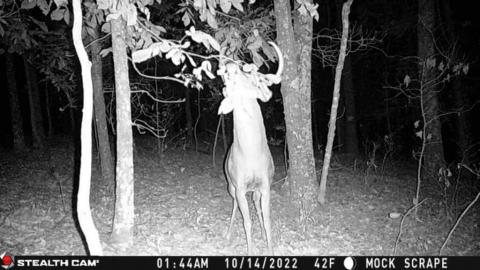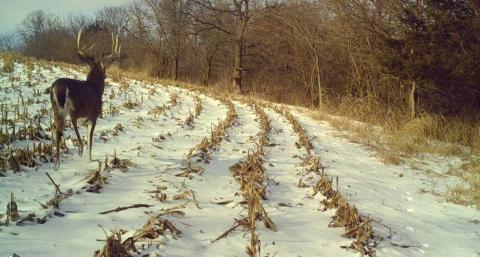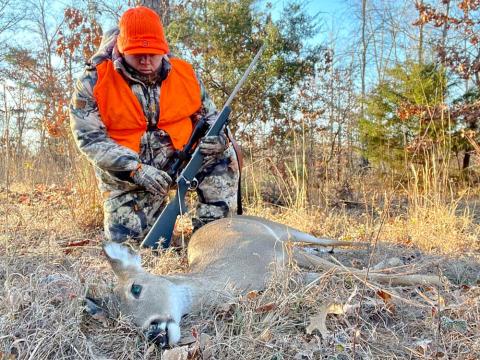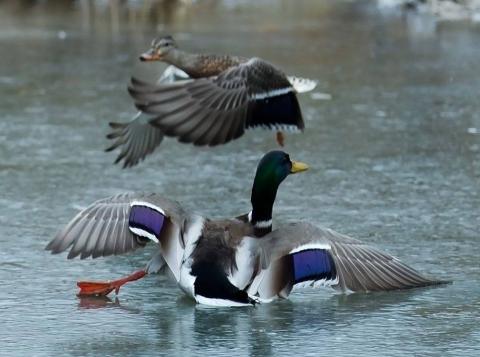Dry Soil Secrets used in the West should be adopted east of the “Big River.”
S. L. Merriam | Originally published in GameKeepers: Farming for Wildlife Magazine. To subscribe, click here.
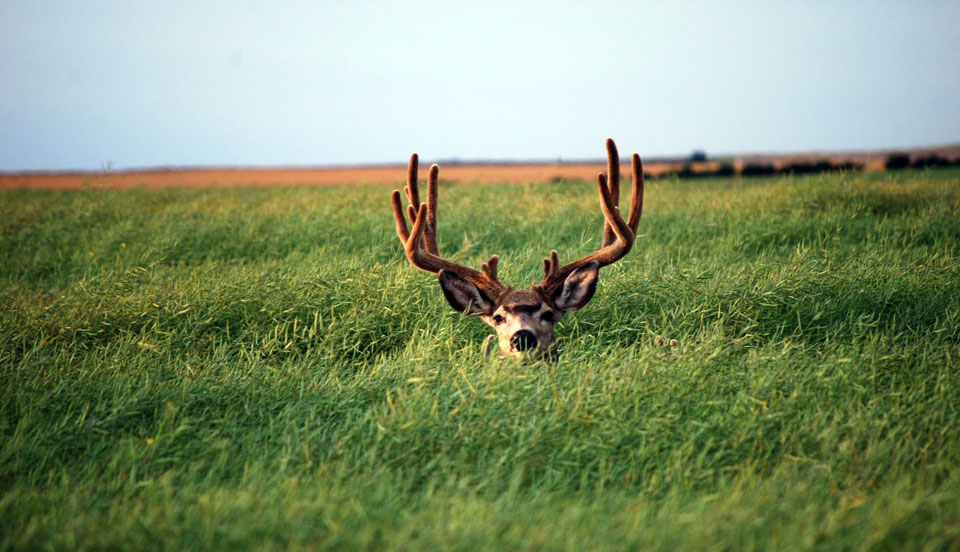
Well before any aspirations of growing a western food plot evolved, Benjamin Franklin made a comment in 1746 that sums up western habitat problems; “When the well is dry, we know the worth of water.” Such simple words define growing conditions in the west during every growing season. Food plot success is directly tied to rain events or moisture than can be collected and held prior to and during a plot’s growth period. On the bright side, when nature’s natural vegetation dries out, the local wildlife will be gripped by your food plot. Your competition is Mother Nature, so when natural foods disappear your green plot becomes the “the only restaurant left open on the block,” so to speak.
This western food plot strategy is aimed at the 17 states well west of the Mississippi starting in the Dakotas and straight south to Texas and then on west from there. They include Nebraska,Kansas, Oklahoma, Texas, Montana, Wyoming, Colorado, New Mexico, Idaho, Utah, Arizona, Washington, Oregon, Nevada and California. While many of these states have areas with sufficient moisture, there is a big difference between the total available moisture in eastern and western habitats. This difference leads many westerners to believe they cannot create a useful food plot, but with a few changes to planting procedures they can enjoy the same benefits food plots furnish to those in the east. With the drought conditions experienced all over the country many would be wise to employ these tips and tricks in other areas.
Lacking reliable water sources, westerners must depend upon Nature to provide moisture. This means planning and designing a food plot to make the most of normally occurring moisture. Planning determines success, so before touching a shovel, tractor or ATV make sure to contact the National Weather Service or the local airport for their charted historical rain and snow data. It’s important to understand the weather patterns that will provide moisture and when they have historically occurred. Such information dictates the ideal time to plant. If your area receives snow as part of the measured moisture remember that snowmelt will not be captured and held in grainy or well-drained soil for plant life to use until air temperature warms enough for the plants to be active and actually draw in that moisture. Learning ways to decrease moisture loss can be one important key to success in dry or well-drained soils.
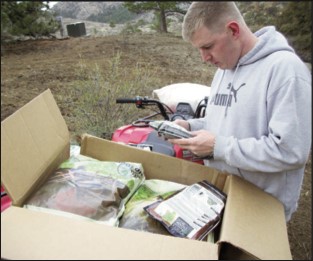
situation” is important for planting in rough
terrain.
The next thing to look at before you begin is the type of farming done in the area, if any, and note how and what local agricultural is actually growing. Why reinvent the wheel? They use what they have learned through trial and error over many years. Note what crops are naturally growing and what crops may require irrigation.
Many places in the west are classified as having “dry land” farming unless there is access to a river or ditch system for irrigation where the landowner has purchased “shares” of that water. Note that he can use the water when there is sufficient volume for his share to become active. No need to go any deeper than that; “water law” in the west is very involved and past water feuds between farmers have ended with a gunshot meaning one farmer no longer needs the water while the other goes to jail. Again, we see how valuable this precious commodity is.
Picking a place to plant is likely the most important decision of the entire process. You are going to have to live with your decision so make it a good one. I want the southern exposure so the plants have the most sun to grow, but depending on water availability it can have a higher risk of burn up. The good attribute is, with water, these sunny spots will grow well and be ready early.
It is also suggested to “spread your bet around.” Don’t put all your eggs in one basket...as they say. So I also plant down in a gully for maximum water and average sun. Then I plant a strip of deep shade to light shade going toward the sun. With blended seed mixes they all will do differently under different conditions and the plants that favor that site will emerge to the forefront. After the first year you will know where to plant each and can be more specific if you wish.
See how much useable moisture you can gain from fall, winter, and spring snows. A low cost snow fence on the windward side of the plot will drop snow on the plot. Early and late storms usually have a warm enough soil temperature so your roots are still able to absorb the gained moisture. If you want to benefit from the winter storms you will need to add peat moss, compost such as leaves, and ground up tree limbs, old straw or hay. Something to hold the cold weather melting moisture until the plant’s roots are able to absorb it. Much of the west in the mountains is primarily decomposed granite which allows water to drain right through below the root line if something is not added to the soil. Make sure to do frequent soil tests because the plant residue, leaves or wood chips can change your soil’s pH and nutrient levels.
It’s a good idea to take pictures of your plot areas periodically so the following year you will see where the snow melts and where it is shaded most of the day. Anything you plant in the areas that contain the most moisture will be a magnet to hungry deer during the winter months when most of their feed sources have deteriorating nutritional values.
Planting location choice will determine if you have a daytime or nighttime food plot. Where in the east you may choose your plot location with this being your major deciding point, in the west we have to choose the spot with the best moisture and then sort out the rest on the back end. When there is cover adjacent to a food plot the plants will attract animals any time of day while a food plot stuck out in the open is more likely to have game feeding only after dark, so those would be our obvious deciding factors.
Plot size will vary depending on your location, equipment and enthusiasm, but I recommend you start small and expand as you learn about moisture, natural fertilizers, pH level and the other things that become more important as you monitor your successes and failures. The rain and moisture information you collected from the National Weather Service will dictate when to plant your seeds to utilize available moisture. Most areas get spring rains, a dry spell, then fall rains...at least they are referred to a “fall rains.” Through much of the country they would actually be “late summer rains.” Both wet periods will be your lifeline to good plant growth. Moisture is the key determinant for success when planting anything for deer no matter where you’re located.
Because much of the good hunting land in the west is mountainous, or at least “hilly,” the key to successful planting on semi-vertical terrain is “mountain terracing.” Building terraces allows you to cultivate sloped land and graduated terrace steps are commonly used to provide level spots and water catchment. Terraced fields decrease erosion and surface runoff, and are effective for growing crops as they channel water into the flat areas for the seeds to utilize.
A terraced hillside can be a prime planting area when designed properly. The first step is to smooth the surface with the excess dirt and pull stones into rows following the contour of the ground. Keep these water catching berms about three feet apart, or more depending upon the size and slope of the terrain. A downhill grade will assist in capturing quick accumulations from a heavy thunderstorm and the heavy water flows will be channeled down the row and not wasted rather than taking out your diversion mounds.
After germination occurs identify the specific sections where your plot stays green and the places where it does not. It helps to take a few pictures for later reference. Go back and check this area during the winter after a snowfall, then again during the spring stages of snow melt and take more pictures to assist in determining where your fall/winter seed growth can best access available moisture.
When your planting area sits on a hillside or along a ravine, the lowest points will naturally catch more water and the natural green growth will be more prevalent because runoff collects in low spots and the water obviously moves slower allowing it to soak into the soil.
On the uphill side of the mound of piled surface dirt and debris, make a trench about six inches deep and six inches wide. The bottom of the depression will become your seedbed. Plant the seeds at a density you feel the moisture can support then make a note of your seed density application and take a picture before covering for future reference. Cover the seed with enough soil to provide a soil depth four times the size of the seed. With small seeds like clover, brassica or chicory, that has a planting depth of 1⁄4 inch or less, it’s best to be on the deep side of any depth range. Where in the east you can broadcast your seeds right on the surface and press it in with a cultipacker, in the west you’ll need it covered for the best shot at germinating moisture.
If you can’t control the rate of runoff before the seeds germinate, pack the trench dirt with your foot to create good seed-to-soil contact and provide a seed to ground interlock. For additional insurance treat the seed before planting with a dry powder called DeltAg’s Seed Coat before planting, because seed depths of a blended seed is multiple depth for ideal thick emergence. Seed Coat provides quicker emergence, you’ll have better roots, and improved growth. Think of it this way, seed emergence and early growth is your most vulnerable time for your plants. Lower that vulnerability by stimulating root growth first, so when the drying sun arrives the plant’s roots will search deep for the moisture.
If you have a temporary water source available, planting is the most important time to water and seat the seeds in the bed. This will help prevent a heavy runoff from moving freshly planted seed, along with the soil. It is worth the effort to haul water if none is available on site.
For a hunting plot to perform best during the fall, plant the seeds just prior to the fall rainy season, which in most areas would be mid-August. Use the National Weather Service data you have already obtained to know exactly when these rains should occur.
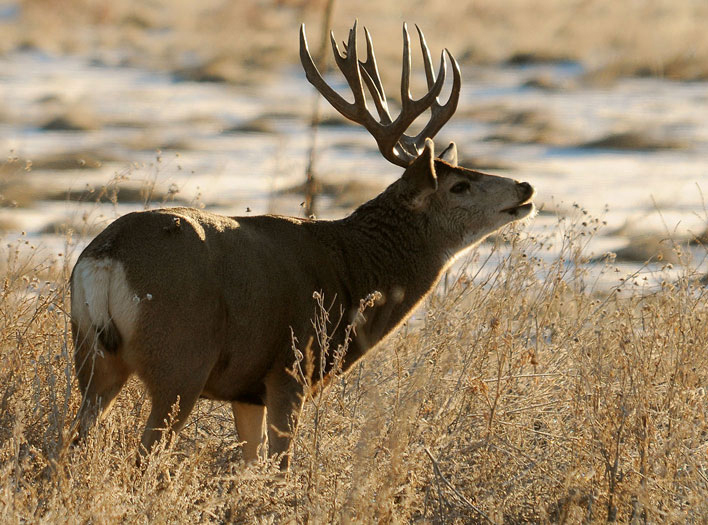
A good plan was told to me by BioLogic’s Todd Amenrud. Todd has done consulting on a number of ranches in CO, WY, NE and the Dakotas, some of which only receive 12 to 14 inches of annual rainfall. Todd says, “We plant BioLogic’s Lablab in the spring and then any one of a number of combinations of late summer/fall plantings. The key is to exploit the moisture when you do have it. And just know that your plots may not be as pretty as those grown east of the Mississippi, but I’m not trying to win a photo contest. I’m trying to feed my deer and draw in a few so I can kill them.” For late summer/fall plantings he recommends; Winter Bulbs & Sugar Beets, Maximum, Full Draw, Last Bite, Green Patch Plus, Trophy Oats, Outfitter’s Blend or their new DEER Radish. He mentioned that lablab was made popular in Texas and does well even in their adverse conditions and it does well as a spring planting wherever you have drier or well-drained soils.
A blend will almost always do better than a mono crop, especially under these conditions. It will provide a wide range of characteristics to protect you from failure. A blend provides plants that are palatable for longer than just one cultivar, while being tolerant to dry periods, because you don’t have control of water timing and amount and each type of seed has a different resistance.
It also should be stressed that you must time your seedbed preparation. Every time you turn the soil with a disk, plow or tiller, valuable topsoil moisture is lost. Once you initially break ground and bust sod the first time, a no-till drill is the best tool for the job. It saves topsoil moisture and helps prevent erosion. Each planting will have certain plant varieties that do better than others depending on the heat, water, wind and snow conditions happen to provide with the key element being water. It seems even as far back as 1746, when Ben was testing thunderstorms for electricity, he realized those storms provided a very valuable by-product. Had Ben lived in the west it would have been even more noticeable!

















